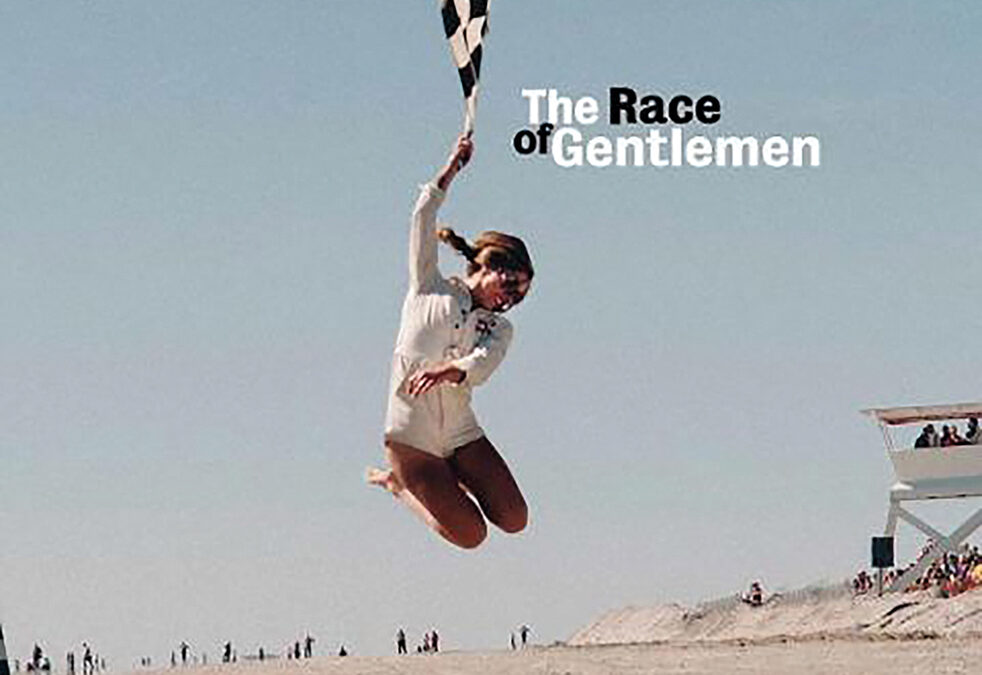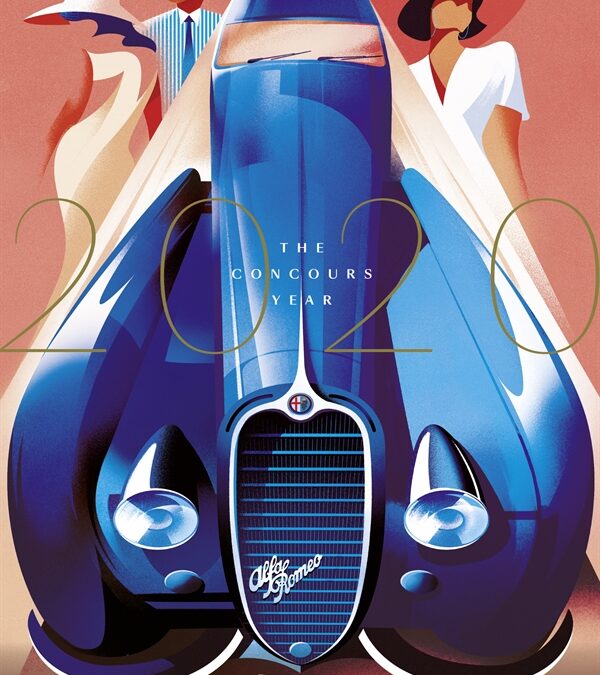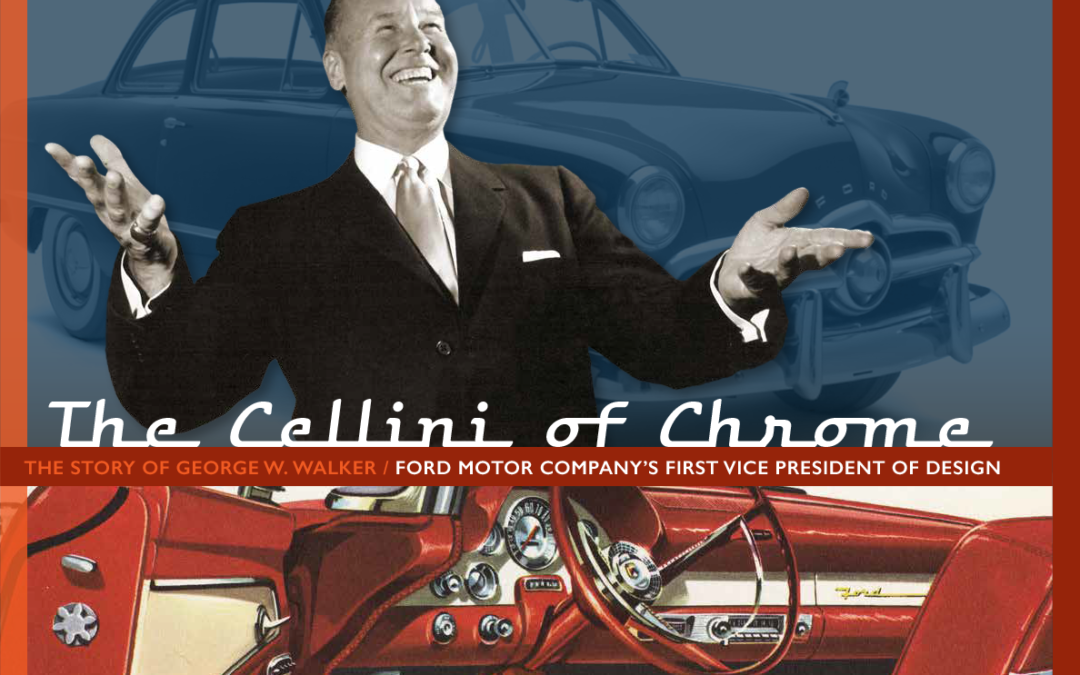
Henry Dominguez’s newest book The Cellini of Chrome, introduces the surprisingly unknown but truly fascinating career of George Walker, the Ford Company’s first full Vice President of Styling.
In the same flamboyant vein as other design greats such as Harley Earl, Gordon Buerig, Vergil Exner, Raymond Loewy and William “Bill” Mitchell, Walker developed the standard for key Ford Motor Company Products for the 1950s and ‘60’s. Beginning with the enormous success of the 1949 Ford, George became the catalyst for the iconic appearance of Ford, Mercury and Lincoln models, elevating Henry’s company to one of the all-around best-selling Automotive operations in the World.
With a personal history anything but bland, his elegant style of dress, appeal to attractive women, signature winning smile, and willingness go toe to toe with industry giants such as Henry Ford II (“The Deuce”) and other top executives, Walker made himself a key figure in the highly competitive environment of mid-20th Century automotive design.
His story is a must for any automotive enthusiast looking for an inside view of how the stylistic character of Ford products was created by Walker and his associates.

The single-engine Junkers Ju 52 first flew in 1930. Designed and built by the Junkers Aircraft Company of Dessau, Germany, the Ju 52 was originally intended as a cargo aircraft. An upgraded model, the Ju 52/3m, was powered by three engines, excelling as an 18-seat airliner. By the late 1930s, hundreds of the safe and reliable Ju 52/3m were serving with airlines in more than 20 countries, including the prewar British Airways. It was used as a bomber by the reestablished Luftwaffe, particularly in the Spanish Civil War. During the Second World War, the Ju 52/3m was the mainstay of the Luftwaffe transport squadrons. Affectionately known as ‘Faithful Old Annie’ and ‘Iron Annie’, the Ju 52/3m was used during the invasions of Norway, the Low Countries, Crete as well as the resupply of Stalingrad and Rommel’s Africa Corps. In all, more than 5,000 were built. After the war, production continued in France and Spain. Amazingly, captured Ju 52/3ms were rebuilt postwar and briefly operated as airliners on domestic routes in Great Britain! Today, about 50 Ju 52/3ms survive, with less than ten flying. The Junkers Ju 52/3m is one of the most significant transport airplanes in the history of aviation.

•Incredible miniature Porsches, photographed in ‘real-world’ settings – each model is 1/43rd scale
•All of the eight 911 generation in 99 models, among them the Porsche ‘Fledermaus’ (prototype TS 901), Porsche 901/911 and the Porsche 911 Carrera S (Porsche 992)
•Handy Porsche compendium, in chronical order from 1962 to 2019
•Informative, historical and technical details to each and every model
Five decades, eight generations, one number: 911.There is no other car as legendary as the Porsche 911. Old-timer, new release or racing car legend; fans worldwide are fascinated.
The Porsche 911, an epitome of a German sports car, is a world-renowned import success and dream car. In this multi-faceted work, the 99 most important models of the legend are presented chronologically as miniatures in a 1/43rd scale, each with a picture and text page, in an informative, entertaining and surprising way: as Urban Outlaw, flat speedster, Germany’s Next top model, as a wolf in sheep’s clothing… all put together by author Jörg Walz, a collector since childhood.
The author places the snapshots of vehicle miniatures in a ‘real’ environment and presents a well-assorted digital car museum. The charming interplay between a small car model set into a lively background is fascinating. The originally spontaneously created photo collection is completely simply “iPhotographed”, without further aids or artificial arrangements, initially taken for Instagram.
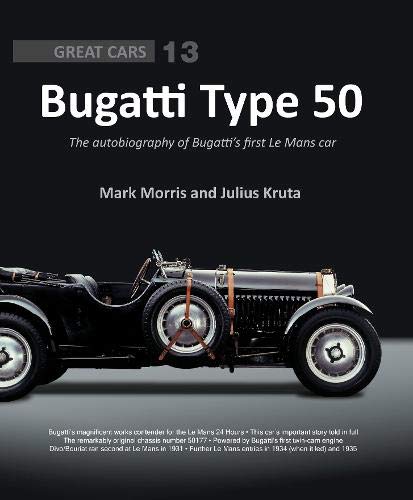
Launched in 1930, the Bugatti Type 50 heralded a new era with the introduction of the Molsheim marque’s first twin-cam design, a supercharged 4.9-litre straight-eight engine of prodigious power. At a time when brute force was needed to win the Le Mans 24 Hours, a competition version was developed and three such Type 50s took part in 1931. The car around which this book is focused, 50177, was leading the famous endurance race when the team withdrew it owing to tyre failures that had afflicted the sister cars, causing one to crash heavily at high speed.
The fascinating story of 50177, and the Type 50 in general, is told in this brilliantly researched and superbly illustrated book in the Great Cars series. Introductory chapters explain the economically perilous world of 1931, the genius of Ettore and Jean Bugatti, the bloodline of large-capacity Bugatti engines, and the Type 46 from which the Type 50 was derived. There follows an in-depth exploration of the Type 50’s design and development, including the Miller inspiration behind its twin-cam engine.
The four Le Mans races in which Type 50s took part form the core of the book and tell a story of promise unfulfilled. The subject car, 50177, raced three times, in 1931 as a works entry with race no. 5 (driven by Albert Divo and Guy Bouriat) and in 1934 and 1935 with works assistance as no. 2 (driven by Pierre Veyron and Roger Labric). A section about the drivers presents illustrated biographies of the four men who raced 50177 as well as the four others in the 1931 works team — Louis Chiron and Achille Varzi in no. 4 and Maurice Rost and Count Caberto Conelli in no. 6. Post-war, three-time Le Mans winner Luigi Chinetti bought 50177 in 1949 and took it to America, where it spent nearly 50 years with five different owners. The last of them was Miles Coverdale, a passionate Bugatti collector who kept the car for 23 years and uncovered much of its history through correspondence with former works mechanics, notably Robert Aumaître.
Co-authors Mark Morris and Julius Kruta, wellknown in the Bugatti world for their immense knowledge and enthusiasm, present a wealth of fresh information and illustration in this fine book.
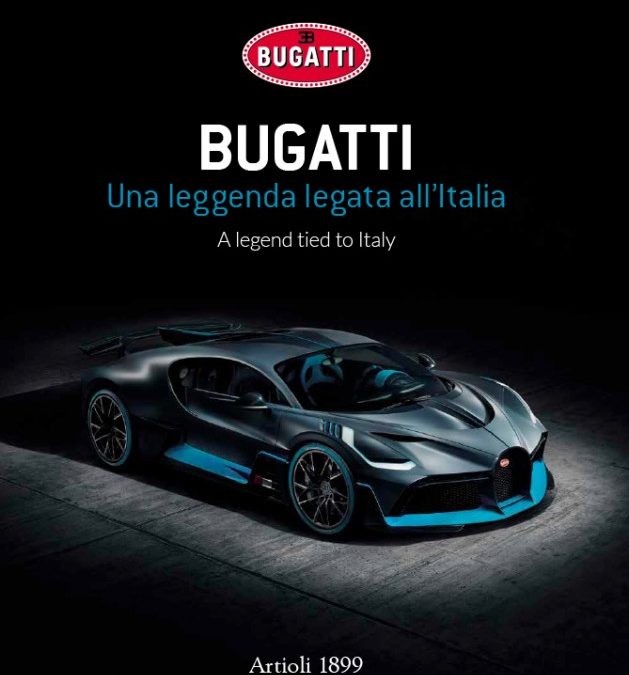
The rediscovery of the wondrous ‘Bugatti’ world made up of extraordinary cars, at centre stage in the first three decades of the last century and magically put back together on the outskirts of Modena between the ’80s and 90s, has taken off again more recently thanks to the boost provided by the Volkswagen Group.
This Group has promoted the making of sensational supercars, which, in terms of features and performance, are by far the most unique cars in the world, ranging from the various versions of the EB 16.4 Veyron on through to the Chiron, which with its 1500 bhp easily reaches 420 km/h, and the more recent Divo at a price of five million euros.
The book begins with an exclusive, long interview with Stephan Winkelmann, President of Bugatti Automobiles S.A.S., who explains the characteristics and the motivating force behind the most amazing brand in the automotive industry.
This is a sensational project symbolically linked with the previous period of management of the Bugatti brand, when through the efforts of the Italian entrepreneur Romano Artioli, the brand underwent a brilliant relaunch, which enabled production of the EB 110 sports car in the futuristic Campogalliano factory. In the mid-1990s, the Bugatti EB 110 was the fastest production car in the world.
Much of the book also deals with Bugatti cars in the days of Ettore Bugatti, who was born in 1881 in Milan and still stands tall amongst the greatest automobile engineers and entrepreneurs. Bugatti cars were meant to be astonishing because of their ingenious features and performance, but also because of their beauty and character.
Retracing the historical transitions of the Bugatti brand is a sort of total immersion in the most exclusive world of motor racing, with continuous transitions between technology, lifestyles, design and the history of costume and fashion.

This book tells the story of every jetliner produced by the Soviet Union, including the Tupolev Tu-104 (the world’s first successful passenger jet), the Ilyushin Il-62 (Aeroflot’s flagship) and the supersonic rival to Concorde, the Tu-144. Other chapters cover the Tu-154 workhorse, the Il-86/-96 jumbo jet and the world’s first regional jet, the Yak-40 (and -42). The meltdown of political certainties coincided with the Tu-204, which was able to form a bridge out of the old Soviet era into the current age. The story of commercial aviation and aero engineering behind the Iron Curtain is told in fascinating detail accompanied by beautiful illustrations taken from Russian archives by Charles Kennedy, one of aviation’s best-known writers. Not only for aviation fans but also a fascinating look Soviet history, European socialism and the evolution of technology. Chapter each on the Tu-104/-124, -134, -144, -154 & -204; Il-62 & -86/-96; Yak-40/-42; and an essay on the history of Aeroflot. Bonus feature: SU s epic winter 1985/86 timetable reproduced in full. 158 pages and over 250 classic pics.
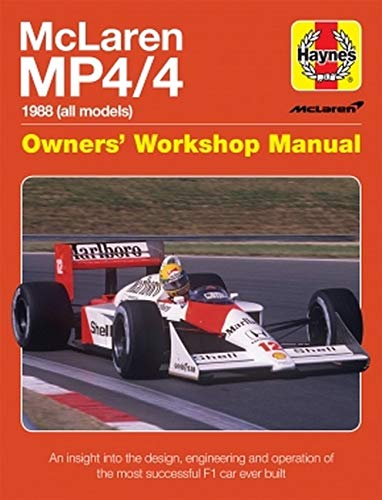
An insight into the design, engineering and operation of the most successful F1 car ever built
The McLaren MP4/4 is the iconic Honda V6 turbo-powered F1 car built by McLaren for the 1988 grand prix season, driven by Ayrton Senna and Alain Prost. Remarkably, the car won all but one race during 1988, and took McLaren’s then-new recruit Senna to his first Drivers’ World Championship after a season-long battle with team-mate Prost. McLaren achieved an astonishing 10 one–two finishes with the car, and suffered only two car-related retirements during the season. The MP4/4 is still statistically the most dominant F1 car ever built.
Ironically, the fact that McLaren was already an enormously successful and well-resourced team prior to 1988 has led to the assumption that producing another winning car in the form of the MP4/4 was simply business as usual. The truth is rather different, with many challenges along the way, mistakes to resolve and, as ever in motor racing, an element of luck, all playing a part in the MP4/4’s extraordinary success.
A wealth of previously unpublished archive material, including original technical drawings and team documentation, provides fascinating new insight into the design and build of the MP4/4.
Produced with the full cooperation of McLaren, and unique access to a race-winning MP4/4 chassis, this manual tells for the first time the accurate story of the design, engineering and operation of one of F1’s most iconic cars, featuring extensive and often candid input from the designers, engineers and drivers involved.
- The McLaren story: Brief history of McLaren prior to the MP4/4 and subsequent history to the present day.
- Design and build of the MP4/4: The full story of how a completely new car, along with a one-off Honda engine, were designed and built for the 1988 season.
- The MP4/4 in action: A race-by-race account of the MP4/4’s performance in the 1988 World Championship.
- The anatomy of the MP4/4: Chassis, aerodynamics, suspension, steering, brakes, Honda engine, transmission, wheels and tyres, cockpit and electrics.
- The drivers: Insight from Alain Prost and test-driver Emanuele Pirro, plus a profile of Ayrton Senna with thoughts from his former teammates.
- Appendices: Specifications, race results and statistics and full chassis histories.

Although there is no doubt that the fame of Innocenti worldwide is due above all to the Lambretta and to the productions in the field of the great mechanics, from the presses to the rolling mills, to the large iron and steel plants, besides all this it is however important to remember also its presence in the field automotive, a presence that since the sixties has proposed, in addition to the production of well-known British cars such as the Mini, specific versions of cars of the BMC group for the Italian market, versions that, both from an aesthetic point of view and for performance , presented remarkable innovations compared to the original models built in the UK, such as the Innocenti Spider and the Innocenti Morris IM3. In a country where the automotive industry was firmly in the hands of the giant Fiat and Finmeccanica with Alfa Romeo, the opening of a new car factory was according to some authoritative figures of the Italian industrial world, a gesture of great courage and, according to others, even a gesture of great unconsciousness.
Italian text

The Land Cruiser is Toyota’s longest continually produced model. From its start as a utility vehicle built during a period of economic gloom and uncertainty after the Second World War, it is now a well-equipped, luxurious and highly capable prestige SUV.This book covers all the changes that have taken place over the years to provide a complete history of the Land Cruiser’s extraordinary heritage. The coverage includes the Land Cruiser’s outstanding success in some of the toughest environments of the world, and what it takes to modify it to meet the toughest of conditions.Author Nigel Fryatt follows the extensive range history of the Land Cruiser from its earliest models, through the utility models, right up to the prestigious versions that exist today. The author draws on his considerable experience of both on-road and off-road testing to provide his informed professional judgement on this extraordinary vehicle.

An insight into owning, operating, maintaining and restoring the Royal Navy’s first armoured iron warship.
Designed and built to challenge an aggressive French shipbuilding program in the late 1850s, when commissioned, the 40-gun, steam-powered, ironclad HMS Warrior was the largest warship in the world.
The revolutionary design housed the main guns, 10 boilers, and steam engine inside an impregnable armored “box”, or citadel, made from 4½in thick wrought iron plates. Warrior is the only surviving example of Britain’s “Black Battlefleet”–the 45 iron hulls built for the Royal Navy between 1861 and 1877. She was restored in the 1980s and is now on public display at Portsmouth Historic Dockyard.

The Mikoyan Design Bureau’s first swept-wing jet fighter, the MiG-15 Fagot, which gained world fame (or notoriety, depending on which side of the Iron Curtain you were on) after the Korean War, served as the basis for a more refined model, the MiG-17 Fresco. No sooner had the MiG-15 entered production and service than the designers decided to increase the wing sweep from 35 degrees to 45 degrees, initially by way of experiment. The resulting aircraft showed higher performance than the MiG-15, exceeding Mach 1 in a shallow dive during a test flight, something the Fagot had been unable to do.
Following its production entry the MiG-17 was constantly improved, with Mikoyan developing a succession of production and experimental versions. Firstly, an afterburning engine was fitted to improve performance. Secondly, the increasingly frequent incursions by NATO reconnaissance aircraft, coupled with the knowledge that the West was developing all-weather fighters, led the Soviet ‘fighter makers’ to develop a number of radar-equipped interceptors. The all-weather versions of the MiG-17 proved to be the most successful and some of them were cleared for production.
Starting in the mid-1950s, the MiG-17P, MiG-17PF and MiG-17PFU (the latter version was armed with air-to-air missiles) were the most widespread interceptors in the Soviet Air Defence Force for the nearly two decades.
The MiG-17F day fighter was widely exported and saw a good deal of fighting, receiving its baptism of fire in the Middle East where Egyptian Frescos were pitted against Israeli Dassault Mystère IVs. However, the type became really famous after the Vietnam War where it successfully opposed the supersonic McDonnell F-4 Phantom II and other US aircraft.
Being displaced from first-line fighter service by more modern types, the MiG-17 and MiG-17F found use as a fighter-bomber–both at home and abroad. The MiG-17F and MiG-17PF saw service with nearly all Warsaw Pact nations, as well as many Asian and African countries and Cuba.
The book fully describes the MiG-17’s development history and charts the type’s combat operations in various major wars and local conflicts. A separate chapter also compares the MiG-17 and its foreign counterparts and the book concludes with details of MiG-17 fleets and operators worldwide.
lllustrated with many unique photos, color side views, line and cutaway drawings this latest addition to the Famous Russian Aircraft series forms a details record of the type and will appeal to modelers and historians alike.
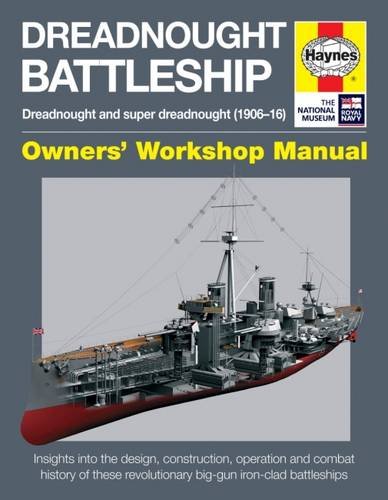
When HMS Dreadnought was commissioned into the Royal Navy in 1906 this revolutionary new class of big-gun iron-clad warship immediately changed the face of naval warfare, rendering all other battleships worldwide obsolete. Known collectively as ‘Dreadnoughts’, these powerful warships from Britain and Germany fought at the Battle of Jutland in May 1916, in the greatest clash of naval firepower in history. Chris McNab gives detailed insights into the design, operation and combat history of these incredible vessels, including coverage of the restoration in Belfast of the light cruiser HMS Caroline – the only surviving Jutland veteran.

This is the emotional story of Patrick Tambay’s rollercoaster Formula 1 ride with Ferrari. The saga began in 1982 with the tragedy of his friend and fellow driver Gilles Villeneuve’s death in the Belgian Grand Prix at Zolder and then unfolded as Tambay took Villeneuve’s place in car number 27, achieved race victories and, as the 1983 season developed, fought for the World Championship. Told in 27 chapters, this is a tale not only of Formula 1 in those colourful years but also a rare and revealing account of life inside Maranello in the twilight of the Enzo Ferrari era, supported by magnificent photographs by Paul-Henri Cahier.
– British GP, 1982: at Brands Hatch Tambay’s second race for Ferrari brings his first-ever podium finish, in his 51st Formula 1 start.
– German GP, 1982: after team-mate Didier Pironi’s career-ending crash during practice at Hockenheim, Tambay lifts his sombre Ferrari team with his first Formula 1 win.
– Italian GP, 1982: in front of Ferrari’s emotional home crowd at Monza, Tambay finishes second, with the great Mario Andretti, his team-mate for this one race, behind him in third place.
– San Marino GP, 1983: Tambay delivers exactly what the Scuderia’s fans desire – victory at Imola for the number 27 Ferrari 12 months after Gilles’s last race.
– South African GP, 1983: Tambay’s farewell race for Ferrari sees him on pole position (his sixth front-row start in seven races), but a mechanical failure denies him any chance of a final victory.
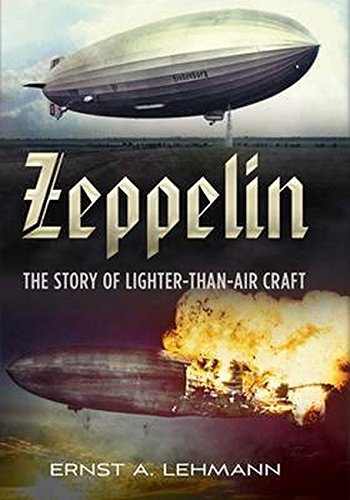
The author of this book, Ernst A. Lehmann, was close to the Zeppelin story from its early days and had great faith in the ever increasing success of the Zeppelin on international routes. It is sadly ironic that this talented man and strong advocate of the Zeppelin should die in Hindenburg disaster shortly after he had produced the draft for this book. He died following the fire that destroyed the Hindenburg on 6 May 1937; he survived the fire itself but was badly burned and died the following day. Lehmann was a Zeppelin commander during the First World War bombing England on numerous occasions, and even met some of the supreme German commanders such as General Erich Ludendorff. He was well acquainted with Count Zeppelin and all of the designers and management of the Zeppelin Company. After the war he worked for the Zeppelin Company under Hugo Eckener, who took over the management following Count Zeppelin’s death in 1917. Lehmann was closely involved in the voyages of the Graf Zeppelin, including the famous round the world voyage, and pioneered services to the Unites States and the regular service to South America. Lehmann makes his Nazi sympathies quite clear, but tactfully does not touch upon his differences with Hugo Eckener regarding the use of the airships for Nazi electioneering-for Eckener was strongly against it. Nor does he touch upon Göring’s maneuvering which broke up the Zeppelin Company, thereby leaving Eckener as an outsider. He believes in the superiority of German engineering and beyond that the superiority of everything German. Lehmann served as commanding officer on more than 100 of the flights of the Graf Zeppelin between 1928 and 1936. In 1935, when Hermann Göring created the Deutsche Zeppelin Reederei to increase Nazi influence over Zeppelin operations, Captain Lehmann was named director of the new airline. In 1936, he commanded 10 round-trip flights to Lakehurst on the new Hindenburg. The text is well-written, approachable, and provides a comprehensive account of the Zeppelin story until the 1937 disaster which cost the author his life.

Two Summers offers a fresh, revealing and highly personal window into the culture of Grand Prix racing as it was during the 1954 and 1955 championships. The core of this book is devoted to individual portraits of the twelve races that comprised the 1954-55 seasons in which the W 196 R participated. Of those races, Fangio won seven and Moss won two.
With its carefully-crafted observations and conclusions, given added drama by its richly-detailed illustrations, there are numerous examples of the energy and dynamic nature of these racing seasons â?? not the least being abundant evidence that Fangio was indeed the ultimate master of the art and science of racing a Grand Prix automobile, and that the W 196 R was the instrument with which he honed his skills. This book captures the decisive moments when victory – hanging in the balance – was tilted towards Fangio by his own steady hand on the wheel and iron discipline.
The W 196 R’s racing days may be long gone, but it remains a shining star of Mercedes-Benz’ participation in motor sport heritage events worldwide.
It’s this timeless appeal of the W196R that gives this book its vitality, charm and enduring attraction.

Discover the allure of forgotten cars.
Something that to the rest of the world is nothing but a forgotten automotive hulk slowly degenerating into a pile of iron oxide is to the car enthusiast something so much more. Like those who restore Victorian homes or antique furniture, car guys see not a decrepit piece of junk, but a desirable object that “just needs some attention.” And should the vehicle abandoned in a field or lying in a creek bed be too far gone to resurrect, car enthusiasts can simply enjoy it for what it once was (while lamenting that it has come to such a sad end).
Finding a lost, restorable car is every auto collector’s dream! Amazing Barn Finds and Roadside Relics taps into the thrill of the hunt with hundreds of photos of lost cars – each accompanied by detailed information covering the nature of the find and details about the car. Ride along as author Ryan Brutt, the “automotive archaeologist,” travels the United States documenting lost and abandoned automotive gems.
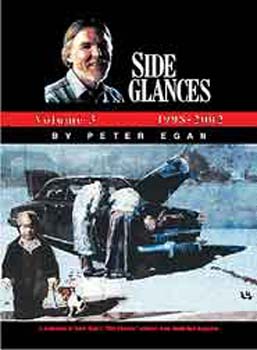
“In every sort of creative environment, there are a number of people who are good, a handful who are poor and very, very few who are truly talented. Peter Egan resides in this last group in the arena of automotive writers. Peter has a unique gift: he is able to take all of the thoughts and feelings each of us has had at one time or another and put them down on paper. His universal appeal is that he speaks directly to our automotive souls. These titles are collections of Peter Egan’s “Side Glances” columns from Road & Track magazine.
Eagan’s 62 stories in this volume include: ‘Decline of the low-cost cult car’, ‘Blissards of the new millennium’, ‘Formula Ford: the best racing there ever was?’, ‘How to tell when you are an older car buff’, ‘Raicng with half your wheels gone’, ‘Romance and the motor car’, ‘Buy a race car and see the world’, ‘Car repair for near-idiots’, ‘Morgans, Old MGs and the wooden canoe’, ‘Portholes and bombsights’, ‘Alabama getaway’, & ‘Garage cleaning tips’. 132 pgs. Sftbd. Volumes I and II also available.”
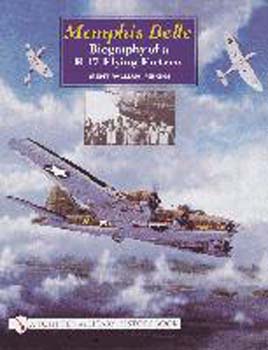
The “Memphis Belle” led a blazing trail of invincibility through the flak and fighter-filled skies over the Third Reich during WWII. After losing a total of nine engines, both wings, both landing gear, and two tails, she was the featured star of a landmark Hollywood film documentary that made her famous the world over. Forgotten and forlorn, the Belle was nearly turned into waffle irons and coffee pots. Here you will read its fabulous story, from bullets to bandages, freezing skies, round engines, and the love that made a B-17 Flying Fortress legend.
